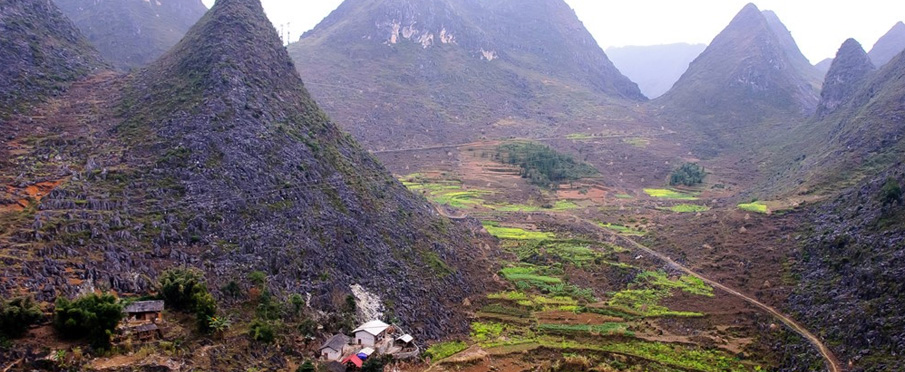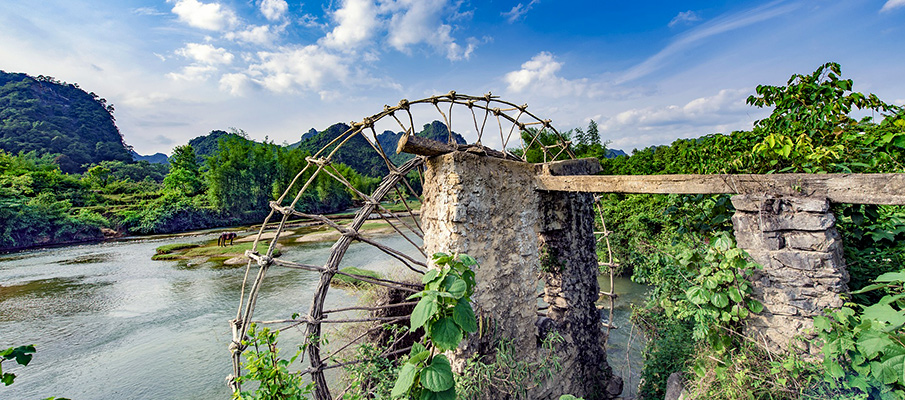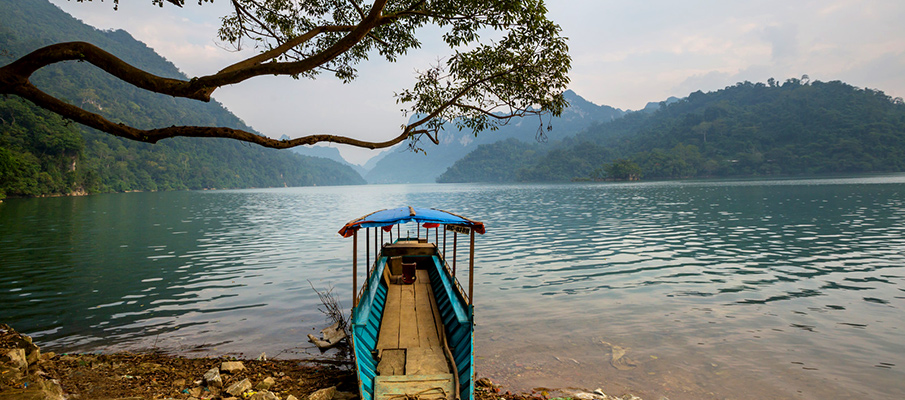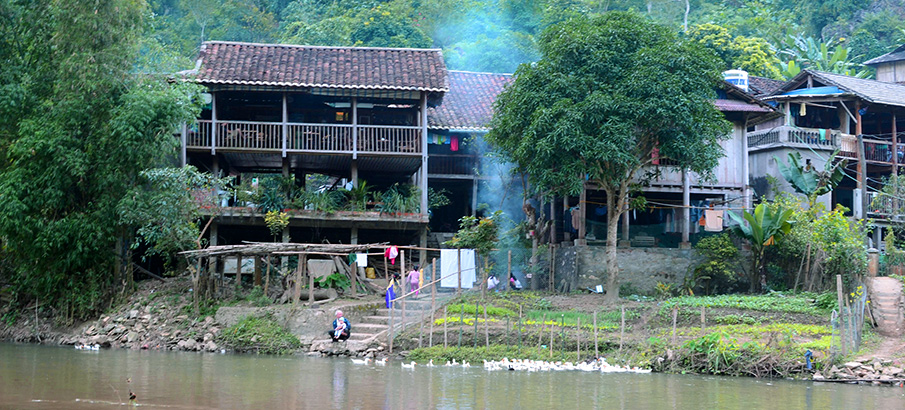CAO BANG – an area of historical significance
CAO BANG – an area of historical significance

Cao Bang is one of the least populated provinces in nothern Vietnam.
Cao Bang province (Cao Bằng) with its capital of the same name borders China on the east of northern Vietnam. There are approximately 550,000 inhabitants in this province. A lot of people are from the ethnic groups such as Tay, Nung, Dao and Hmong.
Practically the entire province of Cao Bang is dotted with hills and villages.
Cao Bang town was damaged in the war with China in 1979 and has since been rebuilt. It lies at an altitude of 300m, so there is a very beneficial climate all through the year. The markets are some of the largest in northern Vietnam, so you need to visit them when you are here.

The area of Cao Bang is a little forgotten by foreign tourists.
Cao Bang is mainly mountainous with spectacular scenery and good trails for trekking and exploring the ethnic minorities in the surrounding villages. In the winter snow fall is possible and there will be freezing conditions in the mountains of Cao Bang province, so be prepared with appropriate clothing. One of the most visited place is Ban Gioc Waterfall on the border with China and also beautiful Thang Hen Mountain Lake. Other beautiful places in Cao Bang are Ky Sam palace, Coi Bin monastery
Cao Bang has several important points of historical significance.
For example Pac Bo Historical Site (at the Bang Giang and Hien rivers). Coc Bo cave is the place where Ho Chi Minh established a revolutionary force in January 1941. In 1920, the area became an important cradle of the revolutionary movement in northern Vietnam. Pac Bo Historical Site include – Coc Bo cave, Lung Lan, Nguom Vai, the house’s floor of Mr. Ly Quoc Sung, Le Nin spring, Cac Mac mountain, Gooc Mu field, Na Chang, Khuoi Nam hut, memorial house of Ho Chi Minh president, etc.
Accommodation in Cao Bang (hotels, homestay…)

Ban Gioc is the 4th biggest waterfall in the world, and leads over the boarder.
Ban Gioc Waterfall is located 80 km north of Cao Bang town on the border with China. Ban Gioc Waterfall is over 200 m wide and the water falls from a height of 70m over 3 sections. In the sunlight you can watch the seven colour waterfall. The colour of the water depends on the weather in this area. You can ride on a boat (bamboo rafts) and watch the waterfall directly, it is fascinating. This waterfall is the largest in Vietnam, but not the highest.
Nearby you will see the Tongling Gorge canyon, accessible only through the cave. You can see a lot of endiginous plants here. About 4 km from the waterfall, you can visit one of the most interesting cave systems in Vietnam – Nguoi Ngao. This is accessible by a one km long paved trail with lighting, and you can see the huge stalactites and go into the 100m high cave chamber.
Only 20 km from Cao Bang town is the beuatiful Thang Hen mountain lake.
Thang Hen mountain lake in Tra Linh District consists of 36 small natural lakes on the hill at a height of 1,000m above sea level. The lakes were formed in limestone formations. An unusual phenomenon of these lakes is that the water level moves like the tide of the sea. The lakes in Cao Bang form the rivers that feed Ban Gioc Waterfall.

Ba Be National Park is a good place for trekking and homestay accommodation.
Ba Be National Park is located about 100 km west of Cao Bang town, it is already in Bac Kan province. It is a good place for trekking and exploring ethnic local minorities or visit Ba Be Lake. Visit some ethnic villages with residents who actually live here. A lot of residents are from the Dao and Tay ethnic group. Around Ba Be Lake there are several villages, with some smaller waterfalls and caves. There are plenty of precious and endangered species that inhabit this region. It is not a problem to stay in homestay, most of them are typical wooden cottages, you can book them here > Homestays in Ba Be National Park.
Ba Be National Park is a valuable natural heritage site of Vietnam.
Ba Be Lake is composed from three interconnected lakes and its length is about 8 kilometers. You can try boating or bamboo rafts and there is an opportunity to explore local caves, with or without the boat. You can stay here in homestay accommodation with the local people and try very good local food. These homestay accomodation houses are adapted for travelers and tourists from Vietnam. You can also travel by bus or comfort limousine directly from Hanoi to Ba Be National Park > Book and buy bus tickets from Hanoi to Ba Be National Park.

Ba Be National Park still holds its unique authentic look.
A very good option is to try a homestay with the Tay ethnic residents in the village of Pac Ngoi. Pac Ngoi is a small village directly by Ba Be lake on the south side of the lake. There are about 30 original buildings of Tay ethnic residents on “stilts“ and there is also accommodation available. Accommodation costs approximately 100,000 Vietnamese dongs for one person.
Pac Ngoi village offers homestay with Tay ethnic residents.
The locals are happy to show you their culture, customs, food offerings, or just sitting by the fire. This village is the best place to be in easy reach of Ba Be lake. For more information about the Tay ethnic group read the article – ethnic minorities of Vietnam.

How to get from Hanoi to Cao Bang:
1. From Hanoi to Cao Bang town by bus:
There are some buses from Hanoi (My Dinh bus station) to Cao Bang, various bus companies. These buses go from Hanoi to Cao Bang town in the morning and in the evening, ticket price is about 160,000-200,000 viet.dongs, and it takes about 6-8 hours to Cao Bang. You can also use some of these buses if you want to get in to the National Park and Ba Be lake. Some buses go over the Phu Tong town, get off there and take a local bus/mototaxi to Cho Ra (10 km from Ba Be National Park). You need to ask your bus driver in Hanoi.
2. From Hanoi to Lang Son and from Lang Son to Cao Bang:
A good choice is also to take a bus or train from Hanoi (Gia Lam bus stop) to Lang Son (+Dong Dang city). In Lang Son you can stay for 2-3 days, explore this area and then continue by bus to the city of Cao Bang. Or you can use a train from Hanoi (Gia Lam station) to Lang Son or Dong Dang city. Use a search engine of transport links vietrailways.com, where you can also buy train tickets online). There is no train connection in Cao Bang province.
How to get from Cao Bang to Ban Gioc waterfalls:
The only way is to travel by bus or motorbike. There are some local buses in Cao Bang town, for a current schedule I recommend to ask at the bus station or at the hotel. If you can, rent a motorbike and travel and explore this very nice area on your own.
How to get from Cao Bang town to Ba Be National Park:
There are 2 roads from the town of Cao Bang to the National park, it is about 130 km. From Cao Bang town some buses go to Phu Thong (ask in the hotel or at the bus station). In Phu Tong take a local bus to Cho Ra town, which is about 20 km. Cho Ra is about 10 km from Ba Be National Park. In Cho Ra take a mototaxi (Xe Om). If you have a motorbike, just look at the map, and go on one of the 2 main roads leading from the city of Cao Bang.
Weather in Cao Bang:
Cao Bang it is not so mountains area like Ha Giang, there are some hills area, but this place lies in lowland. There is very hot in the summer months and in the winter months may be cold. You can visit Cao Bang all year round.
➜ Current weather in Cao Bang
🏡 Accommodation in Cao Bang:
Cao Bang town offers lots of possibilities of various accommodation – hotels, homestays, guesthouses. There is no problem to book some of these accommodation online. You can also find some accommodation at the area of the Ban Gioc waterfalls. You can also find some accommodation on Airbnb. Just see map below.
➜ Accommodation in Cao Bang (hotels, homestay…)
Places of Interest in Cao Bang:
• Pac Bo Historical Site (Coc Bo cave – a place where Ho Chi Minh founded the revolutionary force)
(Pac Bo include Coc Bo cave, Lung Lan, Nguom Vai, the house’s floor of Mr. Ly Quoc Sung, Le Nin spring, Cac Mac mountain, Gooc Mu field, Na Chang, Khuoi Nam hut, memorial house of Ho Chi Minh president, etc.)
• Thang Hen Mountain Lake (+Thác Nặm Trá)
• Ma Phuc pass on the road to the Ban Gioc waterfalls
• Ky Sam palace
• Ban Gioc waterfall, Nguoi Ngao caves , and Tongling Gorge canyon
• Coi Binh Monastery
• Markets in Cao Bang town
• National Park Ba Be in Bac Kan province (Dau Dang waterfall, other caves and local villages)
• homestays at the National Park Ba Be
Cao Bang + Ba Be Lake – tourist map:

Cao Bang is one of the least populated provinces in nothern Vietnam.
Cao Bang province (Cao Bằng) with its capital of the same name borders China on the east of northern Vietnam. There are approximately 550,000 inhabitants in this province. A lot of people are from the ethnic groups such as Tay, Nung, Dao and Hmong.
Practically the entire province of Cao Bang is dotted with hills and villages.
Cao Bang town was damaged in the war with China in 1979 and has since been rebuilt. It lies at an altitude of 300m, so there is a very beneficial climate all through the year. The markets are some of the largest in northern Vietnam, so you need to visit them when you are here.

The area of Cao Bang is a little forgotten by foreign tourists.
Cao Bang is mainly mountainous with spectacular scenery and good trails for trekking and exploring the ethnic minorities in the surrounding villages. In the winter snow fall is possible and there will be freezing conditions in the mountains of Cao Bang province, so be prepared with appropriate clothing. One of the most visited place is Ban Gioc Waterfall on the border with China and also beautiful Thang Hen Mountain Lake. Other beautiful places in Cao Bang are Ky Sam palace, Coi Bin monastery
Cao Bang has several important points of historical significance.
For example Pac Bo Historical Site (at the Bang Giang and Hien rivers). Coc Bo cave is the place where Ho Chi Minh established a revolutionary force in January 1941. In 1920, the area became an important cradle of the revolutionary movement in northern Vietnam. Pac Bo Historical Site include – Coc Bo cave, Lung Lan, Nguom Vai, the house’s floor of Mr. Ly Quoc Sung, Le Nin spring, Cac Mac mountain, Gooc Mu field, Na Chang, Khuoi Nam hut, memorial house of Ho Chi Minh president, etc.
Accommodation in Cao Bang (hotels, homestay…)

Ban Gioc is the 4th biggest waterfall in the world, and leads over the boarder.
Ban Gioc Waterfall is located 80 km north of Cao Bang town on the border with China. Ban Gioc Waterfall is over 200 m wide and the water falls from a height of 70m over 3 sections. In the sunlight you can watch the seven colour waterfall. The colour of the water depends on the weather in this area. You can ride on a boat (bamboo rafts) and watch the waterfall directly, it is fascinating. This waterfall is the largest in Vietnam, but not the highest.
Nearby you will see the Tongling Gorge canyon, accessible only through the cave. You can see a lot of endiginous plants here. About 4 km from the waterfall, you can visit one of the most interesting cave systems in Vietnam – Nguoi Ngao. This is accessible by a one km long paved trail with lighting, and you can see the huge stalactites and go into the 100m high cave chamber.
Only 20 km from Cao Bang town is the beuatiful Thang Hen mountain lake.
Thang Hen mountain lake in Tra Linh District consists of 36 small natural lakes on the hill at a height of 1,000m above sea level. The lakes were formed in limestone formations. An unusual phenomenon of these lakes is that the water level moves like the tide of the sea. The lakes in Cao Bang form the rivers that feed Ban Gioc Waterfall.

Ba Be National Park is a good place for trekking and homestay accommodation.
Ba Be National Park is located about 100 km west of Cao Bang town, it is already in Bac Kan province. It is a good place for trekking and exploring ethnic local minorities or visit Ba Be Lake. Visit some ethnic villages with residents who actually live here. A lot of residents are from the Dao and Tay ethnic group. Around Ba Be Lake there are several villages, with some smaller waterfalls and caves. There are plenty of precious and endangered species that inhabit this region. It is not a problem to stay in homestay, most of them are typical wooden cottages, you can book them here > Homestays in Ba Be National Park.
Ba Be National Park is a valuable natural heritage site of Vietnam.
Ba Be Lake is composed from three interconnected lakes and its length is about 8 kilometers. You can try boating or bamboo rafts and there is an opportunity to explore local caves, with or without the boat. You can stay here in homestay accommodation with the local people and try very good local food. These homestay accomodation houses are adapted for travelers and tourists from Vietnam. You can also travel by bus or comfort limousine directly from Hanoi to Ba Be National Park > Book and buy bus tickets from Hanoi to Ba Be National Park.

Ba Be National Park still holds its unique authentic look.
A very good option is to try a homestay with the Tay ethnic residents in the village of Pac Ngoi. Pac Ngoi is a small village directly by Ba Be lake on the south side of the lake. There are about 30 original buildings of Tay ethnic residents on “stilts“ and there is also accommodation available. Accommodation costs approximately 100,000 Vietnamese dongs for one person.
Pac Ngoi village offers homestay with Tay ethnic residents.
The locals are happy to show you their culture, customs, food offerings, or just sitting by the fire. This village is the best place to be in easy reach of Ba Be lake. For more information about the Tay ethnic group read the article – ethnic minorities of Vietnam.

How to get from Hanoi to Cao Bang:
1. From Hanoi to Cao Bang town by bus:
There are some buses from Hanoi (My Dinh bus station) to Cao Bang, various bus companies. These buses go from Hanoi to Cao Bang town in the morning and in the evening, ticket price is about 160,000-200,000 viet.dongs, and it takes about 6-8 hours to Cao Bang. You can also use some of these buses if you want to get in to the National Park and Ba Be lake. Some buses go over the Phu Tong town, get off there and take a local bus/mototaxi to Cho Ra (10 km from Ba Be National Park). You need to ask your bus driver in Hanoi.
2. From Hanoi to Lang Son and from Lang Son to Cao Bang:
A good choice is also to take a bus or train from Hanoi (Gia Lam bus stop) to Lang Son (+Dong Dang city). In Lang Son you can stay for 2-3 days, explore this area and then continue by bus to the city of Cao Bang. Or you can use a train from Hanoi (Gia Lam station) to Lang Son or Dong Dang city. Use a search engine of transport links vietrailways.com, where you can also buy train tickets online). There is no train connection in Cao Bang province.
How to get from Cao Bang to Ban Gioc waterfalls:
The only way is to travel by bus or motorbike. There are some local buses in Cao Bang town, for a current schedule I recommend to ask at the bus station or at the hotel. If you can, rent a motorbike and travel and explore this very nice area on your own.
How to get from Cao Bang town to Ba Be National Park:
There are 2 roads from the town of Cao Bang to the National park, it is about 130 km. From Cao Bang town some buses go to Phu Thong (ask in the hotel or at the bus station). In Phu Tong take a local bus to Cho Ra town, which is about 20 km. Cho Ra is about 10 km from Ba Be National Park. In Cho Ra take a mototaxi (Xe Om). If you have a motorbike, just look at the map, and go on one of the 2 main roads leading from the city of Cao Bang.
Weather in Cao Bang:
Cao Bang it is not so mountains area like Ha Giang, there are some hills area, but this place lies in lowland. There is very hot in the summer months and in the winter months may be cold. You can visit Cao Bang all year round.
➜ Current weather in Cao Bang
🏡 Accommodation in Cao Bang:
Cao Bang town offers lots of possibilities of various accommodation – hotels, homestays, guesthouses. There is no problem to book some of these accommodation online. You can also find some accommodation at the area of the Ban Gioc waterfalls. You can also find some accommodation on Airbnb. Just see map below.
➜ Accommodation in Cao Bang (hotels, homestay…)
Places of Interest in Cao Bang:
• Pac Bo Historical Site (Coc Bo cave – a place where Ho Chi Minh founded the revolutionary force)
(Pac Bo include Coc Bo cave, Lung Lan, Nguom Vai, the house’s floor of Mr. Ly Quoc Sung, Le Nin spring, Cac Mac mountain, Gooc Mu field, Na Chang, Khuoi Nam hut, memorial house of Ho Chi Minh president, etc.)
• Thang Hen Mountain Lake (+Thác Nặm Trá)
• Ma Phuc pass on the road to the Ban Gioc waterfalls
• Ky Sam palace
• Ban Gioc waterfall, Nguoi Ngao caves , and Tongling Gorge canyon
• Coi Binh Monastery
• Markets in Cao Bang town
• National Park Ba Be in Bac Kan province (Dau Dang waterfall, other caves and local villages)
• homestays at the National Park Ba Be
Cao Bang + Ba Be Lake – tourist map:
Related news
- HANOI – the capital of Vietnam → What to see?
- NINH BINH – karst sceneries and historical sites
- SAPA – fascinating scenery, Hmongs and tourists
- YEN BAI – the province with great potential
- HA GIANG – the most beautiful place in the north
- LAI CHAU – Nature and ethnic minorities
- MAI CHAU – rice paddies and ethnic cultures
- HA LONG BAY – No. 1 tourist attraction
- MOC CHAU – tea plantations and ethnicity
- BAC HA – Flower Hmongs and ethnic markets

